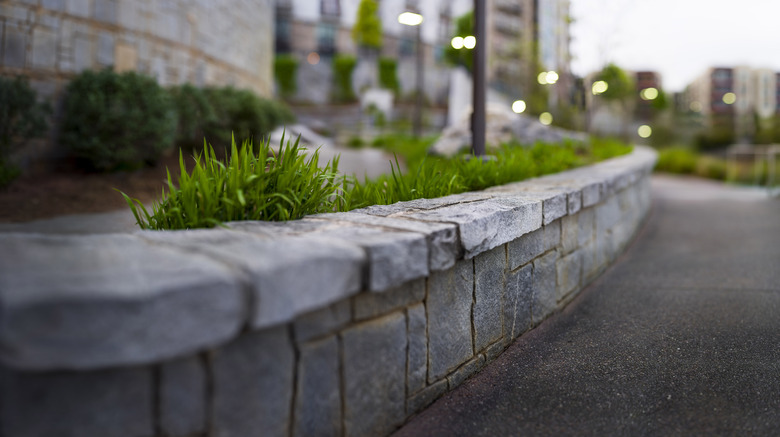How To Calculate Landscape Blocks Needed Using The Radius
We may receive a commission on purchases made from links.
Retaining walls are a stylish way to create defined spaces in landscaping. They can be made with an array of materials, from landscape blocks to wood, and they can be pieced together and supported in a variety of ways. When constructing a retaining wall with landscape blocks, it is necessary to calculate the materials beforehand. If you are building a curved or serpentine wall, you will need to find the radius to calculate the landscape blocks needed.
Choose Landscape Blocks
Choose Landscape Blocks
Many landscape blocks are made to interlock with one another, making the need for mortar unnecessary. They are, however, better suited for walls up to 4 feet tall. For taller walls, landscape block adhesive is necessary for stability.
Picking the right material will depend on the desired look, the height and the location of the wall. They can be made from concrete, a concrete and clay mixture, natural stones or clay brick.
Find the Minimum Radius
Find the Minimum Radius
The radius is the distance from the center point of a circle to the outer edge. When constructing a curved retaining wall, think of the wall as a portion of a greater circle. Curved walls have a larger setback, which means that the wall slopes slightly inward, creating a cone effect. Because of this, the top of the wall will have a tighter radius than the bottom.
To determine the minimum radius for the base course of the retaining wall, first determine the final height of the wall. Pick your landscape block material and use a radius chart to determine the minimum radius for the base course of the wall. (Some radius charts reference specific types of landscape blocks that might not be comparable or available from other manufacturers.)
Depending on the landscape blocks you choose, it may be best to contact the manufacturer directly for the minimum radius for the base and top course since all blocks have different dimensions and fit together differently.
Measure the Radius
Measure the Radius
With the minimum radius and the type of landscape blocks in mind, it is time to measure the radius of the desired space. Stand at the point where the curve will start and measure the minimum radius from the starting point in a straight line, marking the endpoint.
Mark and secure a string the length of the radius to the endpoint and rotate until you reach the end of the curve. If necessary, adjust the radius's length to better fit the space as long as you don't go under the minimum.
If you do not have a minimum radius, you can find the radius with a tape measure. Stand in the center of the area and secure one end of the tape measure to the ground. Then, measure the distance from the point to the farthest edge of the enclosure to find the radius.
Additional Calculations Necessary
Additional Calculations
Necessary
With the radius, plug the value into the following equation: 2 x 3.14 x radius. For example, assume the radius is 25 feet. Use the following equation to find the perimeter: 2 x 3.14 x 25. The perimeter is 157 feet.
To calculate the number of landscape blocks needed for the retaining wall, figure out the length of the landscape blocks in feet. For example, if you are using 6-inch blocks, the blocks are 6/12 or 0.5 feet. Now, divide the perimeter by the length of the landscape block in feet.
Using the example above, the calculation would be as follows: 157/0.5 = 314 blocks. If the answer to your equation is a decimal, round to the nearest whole number. You will also need to account for the height of the wall. You should multiply the number of any additional layers by the number of blocks needed for the first layer.
